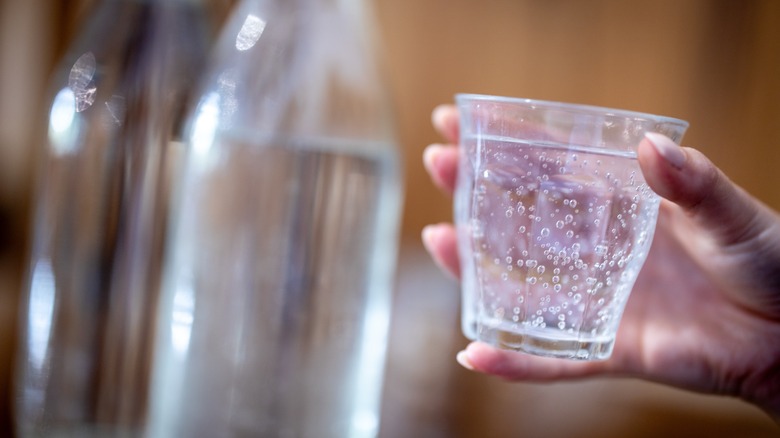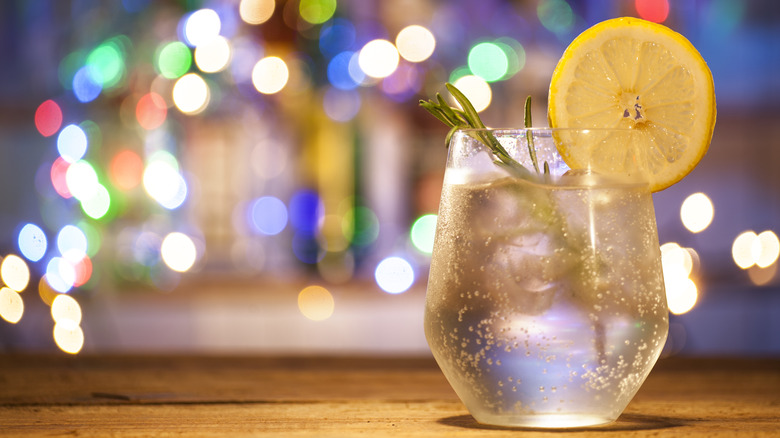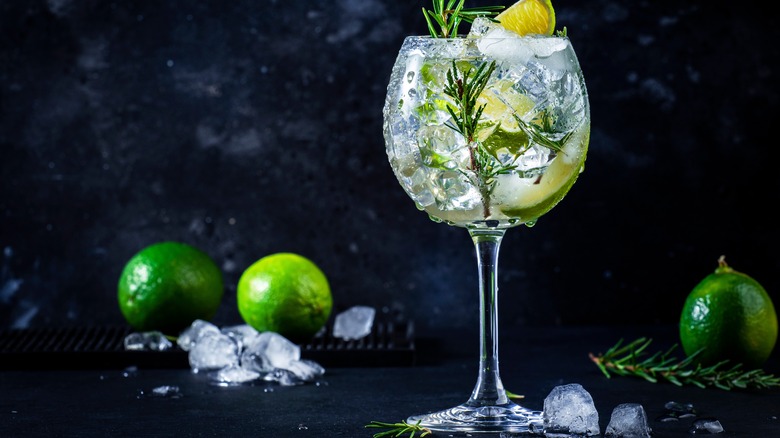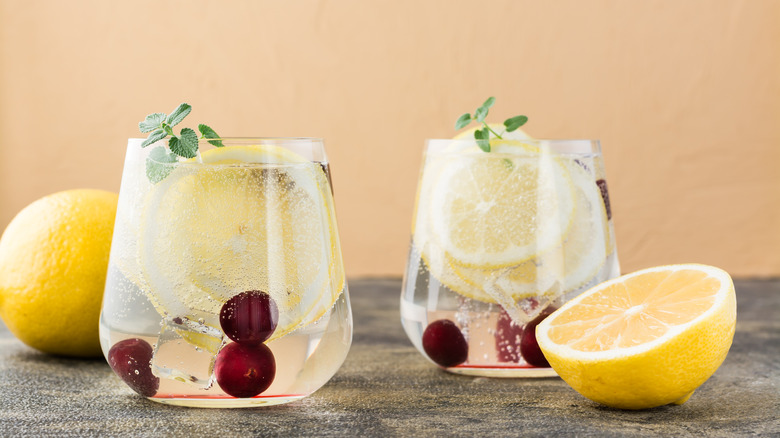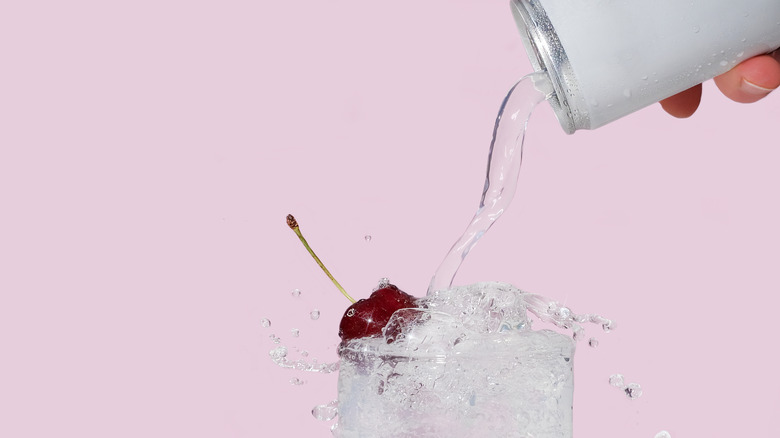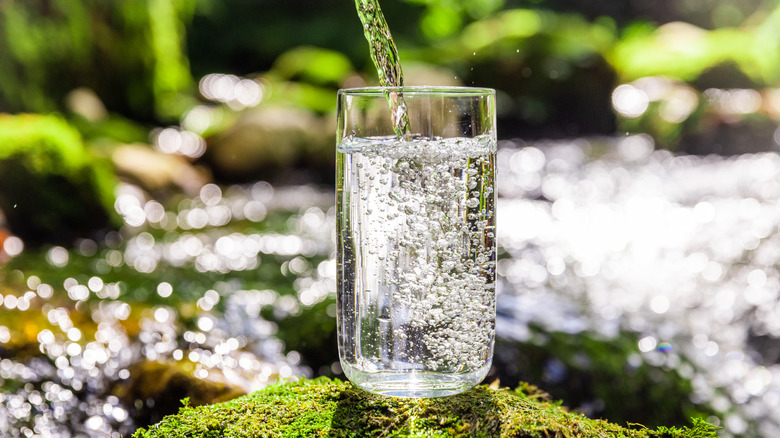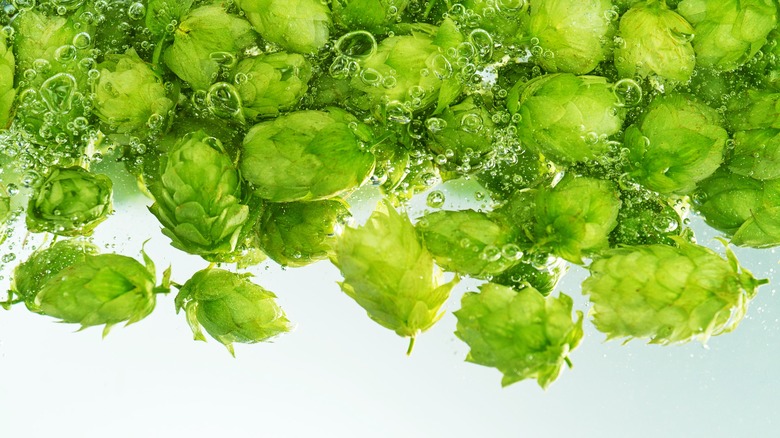6 Types Of Carbonated Water, Explained
Today, the idea of carbonated water is something that we tend to take for granted. It's on the grocery store shelves with a variety of sodas and juices, and anyone who loves a bold gin and tonic cocktail is going to keep some on hand. It's hard to appreciate just what a huge deal it was when one scientist figured out how to make fizzy water, but let's put it this way: When the group that would become the American Chemical Society first met, they chose the grave of Joseph Priestley for their meeting place. Yes, he's the one credited with discovering how to add carbonation to water.
While the introduction of LaCroix may have made sparkling water seem like the trendy new thing on the market, carbonated water was pretty much an instant hit after Priestley published his process in 1772. Johann Jacob Schweppe founded his carbonated mineral water company in 1783, and later — just like fresh milk used to be delivered right to your doorstep, seltzer men would deliver carbonated water to your home. At the time, it was a huge source of income for New York City's Jewish immigrants.
There are a few different types of carbonated water that you might see on store shelves, and yes, there are some differences. Are they interchangeable? Are they made with the same ingredients, with the same nutritional value? It's surprisingly complicated, so let's talk about carbonated waters. (Then, you can click here to learn how carbonation plays an important role when pouring cocktails.)
Club soda
The term "club soda" is often used interchangeably with soda water, although "soda water" can also be used to refer to the whole family of carbonated waters. Here's an interesting thing: You should always read the label before buying club soda. That's because they're not all the same, and different varieties of club soda have different minerals added to them. If you've ever noticed that some varieties of club soda taste a little bit like extremely diluted saltwater, that's because of the sodium that's added. Salt — along with things like sodium chloride and potassium sulfate — is a common additive used in club soda, which means you might want to check labels if you're keeping close tabs on your sodium intake.
Club soda is pretty fascinating stuff, and it's popularly used in a number of cocktails. That's not the only reason to keep some on hand, though, as club soda can be used as a substitute for baking powder. It's also a great option for tenderizing meat, as it'll help break down proteins without changing the flavor of the meat or any seasonings you've added to the marinade.
The combination of added minerals and carbon dioxide means that it's pretty great as a gentle household cleaner. It'll remove some stains; get glass and stainless steel super clean; it will absorb stubborn odors when left in a bowl in the fridge; clean jewelry, and even make cleaning cast iron pans incredibly easy.
Tonic
There are a variety of cocktails that you can make with gin, but it's tonic that's the most popular, most natural fit with the botanical deliciousness that most gin is known for. But what is it? In a nutshell, tonic is carbonated water with added minerals, just like club soda. Tonic goes one more step, though, and adds quinine. Quinine is what gives tonic that bitter flavor, and it's also why some tonics have sugars added.
The history of quinine — and tonic — is a long one, and it goes back to a time when Europeans settling huge sections of Africa and the Americas planted cinchona trees to harvest the bark, extract the quinine, and mix it with water and sugar as a natural anti-malarial treatment. It works, too — and although current research is inconclusive, some suggest it can be used to treat restless leg syndrome and nighttime leg cramps. (It's worth mentioning, though, that although it's deemed safe by FDA regulations, the FDA hasn't approved it as a medical treatment for those conditions.)
It's actually pretty important to know exactly what's in tonic as well, as some people have a sensitivity to quinine that can result in things like stomach cramps and gastrointestinal distress. Anyone who's prescribed quinine is also advised to be careful with tonic, as too much can cause serious side effects including allergic reactions, kidney damage, and vision issues. Tonic water also has the potential to be high in sugar and calories, making label-reading important here, too.
Seltzer
So, here's where things start to get a little confusing, and there's a good chance that someone out there will have an argument for the technicalities that come into play here. For the moment, let's talk about seltzer. A seltzer is technically plain water and carbonation — there are no flavors, minerals, or other ingredients.
Seltzer tends to have the most neutral flavor, without the bitterness of tonic or the saltiness of club soda. That also means that if you're planning on making your own hard seltzers from scratch, this is the stuff that you'll probably want to start with. However, that's not a set-in-stone sort of rule, and in most cases, club soda can be easily substituted in place of seltzer.
Because seltzer has no additives, that can make it a great option for people who want to make it a point to drink more water throughout the day, or, those who want to cut down on the amount of soda and other sugary drinks they consume. If you find plain water boring, try seltzer instead.
Sparkling water
At a glance, seltzer and sparkling water look like they're the same thing, and some sources will claim that they are. However, other sources do differentiate between the two, saying that while seltzer is plain water, sparkling water is carbonated with whatever minerals happen to be in the water when it goes through the carbonation process. That's obviously getting into the finer details of the matter, but it's a technical difference that's worth mentioning.
With that in mind, they are generally interchangeable when used in drinks and cocktails, and if you were to taste them side-by-side, you probably wouldn't be able to taste a difference. A water sommelier could though, which now has you asking, "What's a water sommelier?" Yes, they are professional water tasters in the same way there are wine sommeliers, and they're so sensitive to the flavors and mouthfeel of different waters that they can pick out the mineral content just by drinking it. Neat, right?
Sparkling mineral water
Sparkling mineral water is sometimes considered a specific subcategory of sparkling water, and these are waters that aren't carbonated by an artificial process. Instead, they're extracted from springs already carbonated and naturally containing the minerals that might get added to something like club soda. There's a long history of these springs, even in the U.S. Those who traveled the Oregon Trail in the mid-1800s recorded cold, bubbly water that tasted amazing, and the town that grew up around that water source was aptly named Soda Springs. It was such a big deal that it was exported to the World's Fair in Paris.
Today, we know generally how this works: Volcanic gases dissolve in underground water sources, making mineral-filled fizzy goodness. The water that comes from these springs is delicious, sure, but there's also a long history of medicinal uses here, too. Some of the earliest writings on the medicinal uses of sparkling mineral water go back to ancient Greece, with spas and springs across the Roman Empire being valued for their reputed healing properties.
Today, there's one company in particular that's still selling medicinal sparkling mineral water, and that's Staatl. Fachingen. Located in Germany, the company has been selling this naturally-occurring, fizzy, mineral-rich water since 1742, saying that the water helps balance the levels of acidity in the body. Does it? There is scientific evidence that mineral water might actually help with bone and heart health, and with regulating blood pressure.
Hop water
As far as carbonated waters go, hop water is a fairly new arrival to the line-up. It's exactly what it sounds like: It's carbonated water flavored with hops. The wide variety of hops and the endlessly different combinations result in a myriad of flavors, which are also sometimes further developed with the addition of fruits and teas. Flavor profiles range from floral to citrusy to herby to evergreen and spicy, hitting much more than that and everything in between at the same time.
They're nonalcoholic, but they're not the same as nonalcoholic beers, either — they're carbonated instead of being fermented. Those who prefer hop water of nonalcoholic beer say that this is a low-calorie option that really puts the spotlight on the hops and the flavors they bring, and they range from hop-heavy to lightly flavored. Those who love IPAs will recognize some of the same flavors in hop water that they'll find in their favorite IPAs, and there's a good chance you're going to see more and more varieties of hop water hitting the market.
In 2022, it was announced that sales of hop water had hit $5.5 million, and had risen 143.5% over the previous two years (via the Homebrewers Association). Fast forward to 2024, and hop water is still included in the fastest-growing section of the beer industry, and even breweries are reporting their hop waters are a big hit. Who would have thought?
